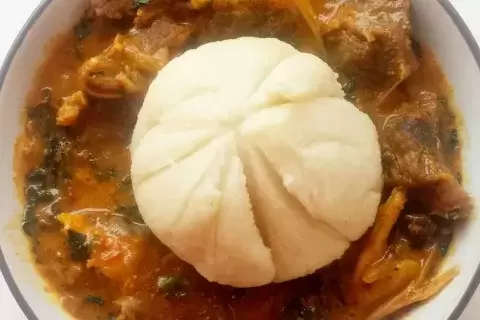Fufu is a staple food in many West African countries, including Ghana, Nigeria, and Cameroon. It is a dough-like dish made from starchy root vegetables such as cassava, yam, or plantain. The preparation of fufu involves boiling the root vegetables until they become soft, then pounding or mashing them to create a smooth and elastic consistency.
Fufu is typically served as an accompaniment to various soups, stews, and sauces. To eat fufu, small portions are usually taken with the fingers and rolled into balls, then dipped into the flavorful sauce or soup.
The texture of fufu can be described as smooth and slightly sticky, and its neutral taste allows it to complement a wide range of dishes. Fufu not only represents a delicious and filling meal but also embodies the cultural significance and communal aspect of African cuisine, where sharing a meal together is a cherished tradition.
Introduction
In this culinary adventure, we will explore the traditional African dish known as Fufu and its perfect companions, the flavorful soups that enhance its taste and cultural significance.
Originating from West Africa, Fufu is a staple enjoyed by many countries across the continent. This simple yet satisfying dish is made from starchy tubers like yam, cassava, or plantains, and it pairs harmoniously with a variety of rich, aromatic soups.
Join us as we delve into the recipe, preparation, cultural significance, and nutritional value of this delectable dish.
Recipe
Serves: 4-6 Preparation time: 30 minutes Cooking time: 1 hour
Ingredients
For Fufu
- 2 pounds yams, cassava, or plantains (or a combination)
- Water for boiling
- Salt (to taste)
For Soup
- Choose one of the following soup options:
- Egusi Soup
- Ogbono Soup
- Okra Soup
- Groundnut Soup
- Palm Nut Soup
(Note: Each soup has its own specific ingredients, so choose one that appeals to your taste buds.)
Preparation
For Fufu
- Peel the yams, cassava, or plantains and cut them into chunks.
- Place the chunks in a large pot, cover them with water, and bring to a boil.
- Cook until the tubers are tender and easily mashed with a fork, usually about 20-30 minutes.
- Drain the cooked tubers and transfer them to a large mortar or a sturdy mixing bowl.
- Pound or mash the tubers vigorously with a pestle or a large spoon until smooth and stretchy. Alternatively, use an electric mixer or blender for a smoother consistency.
- Once smooth, add salt to taste and continue pounding or mixing until well combined. Adjust the salt as needed.
For Soup
- Select your preferred soup and gather the specific ingredients required for it.
- Follow the recipe for the chosen soup to prepare it accordingly.
- Cook the soup until it reaches a rich, thick consistency.
Special Equipment
- Large pot for boiling tubers
- Mortar and pestle or electric mixer/blender for pounding/mixing the tubers
- Cooking utensils for preparing the chosen soup
Serving Suggestions:
- To serve, scoop a portion of the Fufu onto a plate or in a bowl.
- Ladle a generous amount of the soup over the Fufu, allowing it to seep into the crevices.
- Serve hot alongside traditional accompaniments such as fried plantains, grilled fish, or seasoned meat.
- Fufu is traditionally eaten with the hands, so feel free to dig in and enjoy the meal using your fingers.
Nutritional Value
Fufu provides a good source of carbohydrates, dietary fiber, and essential vitamins and minerals. The specific nutritional content may vary depending on the type of tuber used.
Soups accompanying Fufu often contain protein from meat, fish, or legumes, as well as an array of vegetables and spices. These soups contribute to a well-rounded meal, offering a balanced mix of nutrients.
Cultural & Traditional Value
Fufu holds deep cultural significance in many African communities. It is often prepared during festive occasions, family gatherings, and community celebrations.
The communal aspect of preparing and eating Fufu brings people together, fostering a sense of unity and shared experiences. The accompanying soups are not only delicious but also showcase the diverse flavors and culinary traditions of various African regions.
Exploring Fufu and its soups is an opportunity to appreciate the cultural heritage and gastronomic richness of Africa.
Conclusion
Preparing Fufu and accompanying soups is a delightful way to experience the vibrant flavors of African cuisine. This iconic dish reflects the culinary diversity and cultural heritage of the continent.
So gather your ingredients, immerse yourself in the cooking process, and savor the wholesome combination of Fufu and its delectable soups.
Enjoy the rich flavors, communal dining experience, and a glimpse into the traditions that have been passed down through generations.















